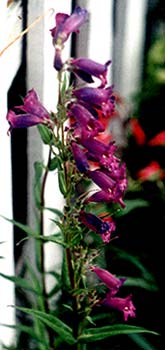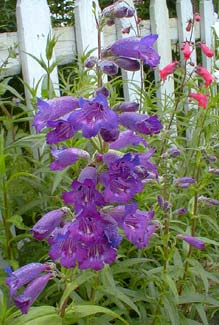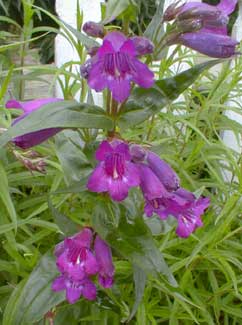
'Sour Grapes'
Beard Tongue
"I hide myself within my flower,
That fading from your Vase,
You, unsuspecting, feel for me --
Almost a loneliness."
-Emily Dickinson
(1830‚1886)
(1830‚1886)
In 1999 through 2000, we concentrated so much on putting in the "bones" of our garden with big shrubs & trees, we ended up with not a lot of flowers attractive to hummingbirds. There was a big old abelia & a few suchlike, & hummingbirds do like to visit some of the rhododendrons, but mainly those bloom too early because the hummers show up in summer.
So overall, the hummers would visit us, find what little they could find, then depart just as suddenly. But in 2001 & 2002 we began "filling in the cracks" of the garden with increasing numbers of vines & perennials, many with tubular or trumpet-shaped flowers of special fascination for hungry hummers. Among these, penstemons seem to hold a special fascination for hummingbirds, lending me to presume these flowers produce even more nectar than do many of the other things hummingbirds enjoy.
 The 'Sour Grapes' penstemon when originally planted from out of a pot was already in full bloom, & the very next day while in the garden, I turned my head to a sound that was rather like a humongous moth. There was a tiny grey-green hummer feasting from that very penstemon.
The 'Sour Grapes' penstemon when originally planted from out of a pot was already in full bloom, & the very next day while in the garden, I turned my head to a sound that was rather like a humongous moth. There was a tiny grey-green hummer feasting from that very penstemon.Later that same day when I was sitting in the side yard, the same or another hummingbird came within a couple feet of me, checking out all sorts of flowers for possibilities. It came back a second time to check (then reject) the pale violet flowers of lilyturf, then seemed inordinantly curious about a pool of dwarf cattails that had no blooms. Must've been a little disappointing to the little bird, but I still wonder what it expected it might find there & why it took a second look.
But it found plenty else to delight itself, as we by then had tubular flowers up the wazoo: multiple varieties of bee balms, extensively vining honeysuckles, cultivars of cape fuchsia, a bright red crossvine or trumpet-creeper, some hummingbird sage & other salvias, flowering currants, & on & on.
 So nowadays, hummingbirds are regular visitors. One day in June as I stood watering a sun-garden, a hummingbird came to within three inches of my fingers, because I was holding a garden hose & the hummer wanted to hover right beside my hand, curious about the stream of water.
So nowadays, hummingbirds are regular visitors. One day in June as I stood watering a sun-garden, a hummingbird came to within three inches of my fingers, because I was holding a garden hose & the hummer wanted to hover right beside my hand, curious about the stream of water.'Sour Grapes' has a muddled garden history, not least because three strains carry the same name without sufficient records to establish precidence. I think ours is the one which Way & James in The Gardener's Guide to Growing Penstemons would like to see renamed 'Lambrook Sour Grapes,' because developed from plants growing at East Lambrook Manor in Somerset in the 1950s, & is darker in shade than the one Way & James would specify as 'Washfield Sour Grapes' distributed by Washfield Nursery in Devon & Kent in the 1930s. The third strain baring this name may be derived from P. murrayanus & probably not presently available through commercial cultivation.
The species or group of hybrids from which it was derived is likewise greatly in question, & I won't try to synopsize the contradictory possibilities suggested by several authors. The usual designation of these old mixed-up hybrids is P. x campanulatus though this frankly isn't at all likely to reflect this one's primary heritage.
Even though 'Sour Grapes' along with many other older hybrids are collectively known as "European Penstemons," the original native species were from Mexico. Gardened varieties are nevertheless misnomered "European" because they became fashionable in Europe long before they were fully appreciated in the Americas. In mid-19th Century England, there were entire gardens, or at least long full borders, consisting exclusively of varieties of penstemons.
'Sour Grapes' grows to about thirty inches including the spike of lavender-blue flowers. It's a tough little evergreen perennial in warm & in temperate zones, but is not terribly cold hardy in more northerly climates.
Here on Puget Sound it rarely gets cold enough to trouble them, & 'Sour Grapes' is especially big & bushy all through the winter. Still, as with most Beard Tongues, it is not notably longlived as a perennial, & after a few very happy years, may begin to fade out of the garden. It may self-seed & thereby persist indefinitely, but seed-grown specimens may not look quite like the parent. The original clump can sometimes be refreshed by division after a few years, though penstemons tend to resent being dug up, so the better method of keeping the same penstemons in the yard is to have a dedicated coldframe for doing starts from cuttings, or to have an ongoing nursery source for young plants with which to periodically start over.
P. x campanulatus 'Garnet'